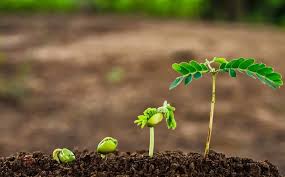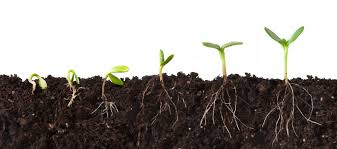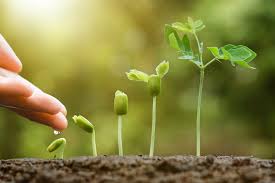Growth in plants results from the combination of cell division, cell enlargement, and the differentiation of new cells into various tissue types. These changes are usually permanent and often involve an increase in size (length or volume) or in the dry weight of plant parts.
In plants, growth occurs only in meristems. For example, the apices of roots and shoots are occupied by primary meristems, while secondary meristems (cambia) in older plant parts produce additional vascular tissues and cork cells.
The activity of one meristem often influences nearby meristems, a relationship known as growth correlation. A good example is apical dominance, where the active apical shoot meristem inhibits the growth of nearby lateral bud meristems.
Types of Plant Growth in Agriculture
Growth can be determinate, where an organ or entire plant grows to a certain size and then stops, or indeterminate, where cells continue dividing indefinitely.
Most plants exhibit indeterminate growth, which is a major reason for their continued productivity under favorable conditions.
Cell Differentiation in Agricultural Plants
Differentiation refers to the transformation of generalised cells into specialised ones that differ in form and function. Despite having the same genetic makeup, meristematic cells differentiate based on gene expression and suppression.
The location of a cell influences its development; for example, root cells do not develop in flowers, nor do petals form on roots.
Read Also: Peach Rose Flowers (Persian Yellow): All You Need To Know About
Techniques Used to Measure Plant Growth in Agricultural Studies

1. Weighing Plants: Fresh and Dry Weight Method
i. Measuring Fresh Weight: Although it is possible to weigh fresh plants without causing damage, removing them from their medium may stress the plants and alter growth. Fresh weight should therefore be recorded only at the end of an experiment.
Procedure:
i. Uproot the plant and remove soil gently.
ii. Blot excess moisture using soft paper towels.
iii. Weigh the plant immediately to avoid moisture loss.
2. Measuring Dry Weight: Dry weight provides a more reliable measure of plant growth, as water content varies with environmental conditions.
Procedure:
i. Uproot and clean the plant.
ii. Blot to remove moisture.
iii. Dry in an oven at 100°F overnight.
iv.Let cool in a dry place (e.g., inside a Ziploc bag).
v. Weigh using a milligram-sensitive scale.
Read Also: Significance and Uses of Monkey Orchid Flowers
Root Mass and Its Importance in Plant Growth Evaluation

1. Root Mass Measurement: This is generally a final measurement, requiring uprooting of the plant. Techniques include:
i. Clean and dye light-colored roots (if necessary).
ii. Lay roots on a grid and count intersections.
iii. Trace and measure root outlines.
iv. Count total root numbers.
v. Measure root diameters useful for crops like carrots and beets.
Root-to-Shoot Ratio: A Key Indicator of Plant Health
Healthy roots absorb water and nutrients efficiently. The root\:shoot ratio helps determine plant health, with deviations from control group values indicating potential stress or vigor.
Procedure:
i. Uproot and clean the plant.
ii. Dry at 100°F overnight.
iii. Cool in a moisture-proof setting.
iv. Weigh the plant.
v. Separate roots from shoots at the soil line.
vi. Weigh both parts.
vii. Calculate:
Root/Shoot Ratio = Root Dry Weight / Shoot Dry Weight
Measuring Plant Growth through Observation in Agricultural Experiments
Observational methods are practical for tracking plant health and development. Below are key features and how often they should be recorded:
| Measurement | Procedure | Frequency |
|---|---|---|
| First Cotyledon | Record days from planting to cotyledon emergence. | Once |
| Germination Percentage | Calculate percent germinated under each experimental condition. | Once |
| Plant Height | Measure from container edge to stem tip (not soil surface). | Every 2–3 days |
| Number of Leaves | Count all visible leaves, including emerging tips. Use graph paper for accuracy. | Every 2–3 days |
| Leaf Surface Area (3 methods) | 1. Trace on graph paper and count squares. 2. Trace on uniform dry paper, cut out, and weigh. 3. Use digital imaging software. | Every 2–3 days |
| Plant Color | Note any changes or differences in leaf color. | Every 2–3 days |
| First Flowering | Record days from planting to appearance of the first flower. | Once |
| Number of Flowers | Count all flowers and buds. | Every 2–3 days |
Importance of Measuring Growth Parameters in Agricultural Management
Regular assessment of growth parameters aids in understanding their contributions to yield. These measurements also guide decisions that can improve productivity through adjustments in agricultural practices.
Plant growth, whether determinate or indeterminate, proceeds as meristematic cells divide and differentiate into tissues and organs.
These developments provide measurable parameters such as height, leaf number, and biomass, which help in evaluating performance and yield potential in agricultural systems.
Do you have any questions, suggestions, or contributions? If so, please feel free to use the comment box below to share your thoughts. We also encourage you to kindly share this information with others who might benefit from it. Since we can’t reach everyone at once, we truly appreciate your help in spreading the word. Thank you so much for your support and for sharing!

